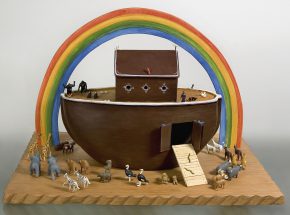

Born in 1950 and raised in Santa Fe, New Mexico, Luis Eligio Tapia grew up during an era that stressed cultural homogenization. It was typical for Hispanics to submerge their Latin identities. For example, growing up, Tapia was known as “Lou” or “Louie” to his friends, a more anglicized version of his Latin name. He graduated from St. Michael’s High School in 1958 and studied briefly at New Mexico State University. In 1969, Tapia married a fellow artist, the former Star Rodriguez. Tapia worked a retail job at Cooper’s Western Wear for five years—he was hired as a stock boy in 1969, and had been promoted to store manager by the time he left, in 1974. During the sixties and seventies, as many Hispanics of Tapia’s generation grew older, they began to rediscover their heritage and Latin roots. Tapia was a founder of La Cofradia de Artes y Artesanos Hispanicos. The group helped revive Hispanic art in the Southwest in the early 1970s. Tapia and his wife had a son and a daughter before they divorced in 1980.
Tapia was drawn to traditional Hispanic crafts during the civil rights movement of the 1960s. He was involved in the Chicano farm workers’s struggles in California and with the militant land reform movement in the villages of northern New Mexico. The experiences compelled Tapia to discover his Hispanic heritage. Like many folk or craft artists, Tapia had no formal art training, but he pursued his interest by studying Hispanic carvings in the Museum of International Folk Art in Santa Fe, New Mexico. He got his start by restoring antique works, and used his retail experience to build a restoration and furniture business. Among his most important works is an early 19th-century altar screen that he repainted for the church at Rancho de Taos.
Tapia began carving his own santos in 1971, giving his first experiments away to older people. The response was so great that people began seeking him out. Tapia’s best-known pieces are his carvings of Dona Sebastiana, a popular death figure. Part skeleton and part woman, the frightening Dona Sebastiana rides in her carreto de muerte, or death cart, as Tapia carves her. He adorns his “Nuestra Senora de Guadalupe” with an aura made of painted lightening bolts. His works range in height from eight inches to seven feet tall. He has carved retablos and reredos for church altars that have measured up to 20-by-40 feet. Tapia has strayed from his more-traditional santeros work and has developed a more contemporary, cubist style. He also had built a collection of sleek and sensual carvings of nudes and guitar players, and some abstract works. His recent works include painted carvings of noble characters, including Homage to Patrocino Barela, a santero of the 1930s who broke into the New York art scene and became popular with the media, and Immaculate Heart of Mary. Both pieces illustrate Tapia’s capability for refinement.
In 1987 Houston’s Museum of Fine Arts and the Corcoran Gallery in Washington, D.C. organized a traveling art exhibit called Hispanic Art in the United States. Unlike Felix A. Lopez, the other santero represented in the show, Tapia sought to make a place for himself in the mainstream art world. While Lopez strove to devote himself full-time to being a santero, Tapia’s goal always has been to represent his work among popular works of contemporary art. In 1980 Tapia received a very mainstream honor—he received a grant from the National Endowment for the Arts to fund his work. His work has been shown many times at the Museum of International Folk Art. It is a part of the permanent collections of the Smithsonian Institution, the National Museum of American Art, and the Los Angeles Craft and Folk Art Museum.
One of the greatest limitations on a santero is the need to adhere to tradition. Artists’s style, form, and media are often constricted by some collector’s and purist’s need for the traditional. This can mean any deviation from the traditional aesthetic or craft. For some, this means that Tapia breaks tradition. If he does so, it is with no intention to disrespect or satirize the traditional forms. Rather, he considered his work to be in a constant dialogue with tradition, updating it so that it can remain a vital part of contemporary work. He “looks for the nourishment of blending tradition with contemporary culture so that the tradition may continue to grow and flourish,” suggested his biography, located online at the Collector’s Guide Website. At first glance, Tapia’s work may look quite traditional, but in the seventies he was ridiculed for his use of modern paints that produce brighter colors. Tapia has said he imagines the old santeros would appreciate the bolder colors. He used a mix of both modern and antique chisels and rasps, while the authenticity of an artist’s tools can be of great concern to a purist.
For a number of years Tapia participated in the Spanish Market and artisan’s competition, which is held every July in Santa Fe. The Market is the most important venue for Hispanic artists in the Southwest, according to Stephen Lewis in American Craft. Like many artists trying to forge new ground with their work, Tapia is frustrated by what he considers the Market’s “overly literal adherence to ‘tradition,'” Lewis wrote. When the Spanish Colonial Arts Society insisted Tapia forgo showing his own new designs and copy the work of older santos, he declined. “I believe in the tradition,” Tapia told Lewis in an interview. “I am the tradition.”
http://biography.jrank.org/pages/3223/Tapia-Luis-1950-Sculptor.html
Website
https://luistapia.com
